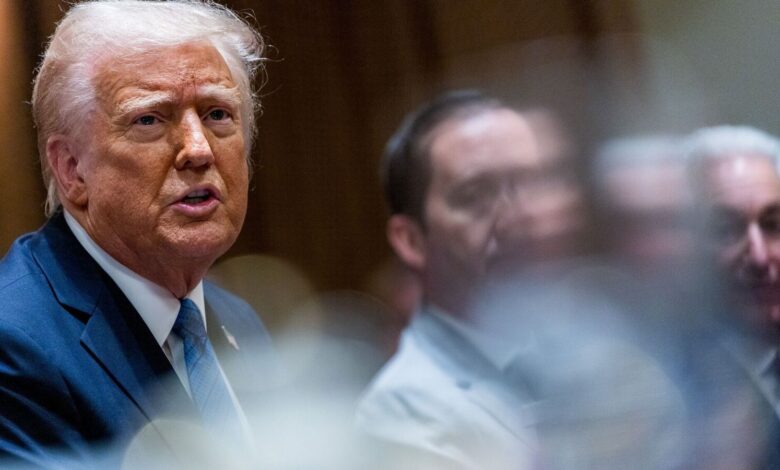From 200% tariff on European wine to 25% on auto imports — A timeline of Donald Trump’s trade war

US President Donald Trump’s tariffs on trading partners are expected to ignite a global trade war, especially targeting China, Canada, and Mexico. The latest list of tariffs includes 25% tariffs on automobiles imported to the US.
However, levying tariffs is not a new development under the Trump administration. During his first term, the US was also engaged in a trade war with China. In his second term, Trump adopted a similar strategy.
Let’s take a look at what has happened so far:
January 20
Soon after officially entering the Oval Office, Trump promised to charge“tariffs and tax foreign countries to enrich our citizens.”
On his first day in office, Trump also said he expects to impose 25% tariffs on Canada and Mexico starting on Feb. 1 while declining to immediately elaborate on plans to tax Chinese imports.
January 26
Colombian President Gustavo Petro rejected two US military aircraft over the ill-treatment of immigrants. In response, Trump threatened 25% tariffs on Colombian imports. Petro announced a 25% increase in tariffs on US products as a retaliatory measure. However, this decision was later reversed.
February 1
The US President signed an executive order imposing tariffs on goods from Mexico, Canada, and China. A 10% tariff was levied on imports from China and 25% on goods from Mexico and Canada. All three countries announced retaliatory measures against the executive order.
February 3
Trump halted his decision on tariffs against Mexico and Canada for 30 days as both countries assured to address concerns about drug trafficking and border security.
February 4
A 10% tariff on Chinese goods imported to the US has come into effect. As a retaliatory measure, China imposes a new set of duties against US goods and an anti-monopoly investigation into Google.
February 10
Trump announced an increase in tariffs on steel and aluminium and removed exemptions introduced in 2018 from March 12 onwards. Hence, steel imports would be charged at least 25%. Aluminium tariffs also increased to 25% from 10% in 2018.
February 13
Trump announced reciprocal tariffs to hike US tariffs according to its trading partners “for purposes of fairness.”
He indicates that in addition to China, Canada, and Mexico, additional countries, such as India, may witness a tariff hike. He also mentioned the plans to impose 25% tariffs on European nations.
February 25
Trump asked the Commerce Department to consider if a tariff on imported copper is required to protect national security.
March 1
Trump asked the Commerce Department to consider whether tariffs on lumber and timber are needed to protect national security as the construction industry and military depend on the supply of wooden products.
March 4
Tariffs on imports from Canada and Mexico come into effect. Tariffs on Chinese goods were doubled to 20%.
The then Canadian Prime Minister Justin Trudeau announced tariffs on over $100 billion of US goods in 21 days. Mexican President Claudia Sheinbaum also assured the imposition of retaliatory tariffs on US goods. China levied 15% tariffs on a range of farm exports.
March 5
The US President gave a one-month exemption to tariffs on goods from Mexico and Canada for US automakers.
March 10
In response to Trump’s 20% tariffs, China imposes an additional 15% tariff on US products such as chicken, pork, soybeans, and beef. However, China’s Commerce Ministry said that goods already in transit would be exempted from the retaliatory tariffs till April 12.
March 12
Trump increased tariffs on all steel and aluminium imports to 25%. As a retaliatory measure to this, the European Union announced new duties on US products such as steel, aluminium goods, textiles, home appliances, motorcycles, bourbon, peanut butter and jeans.
March 13
Trump planned to impose a 200% tariff on European wine, Champagne and spirits if the European Union levies a 50% tariff on American whiskey.
March 24
Trump announced the imposition of a 25% tariff on countries buying oil or gas from Venezuela starting April 2. This would likely impact China, which imports 68% oil from Venezuela.
March 26
Donald Trump announced a 25% tariff on auto imports, aiming to promote domestic manufacturing. However, concerns arose on automakers who depend on global supply chains for manufacturing.
Catch all the Business News , Breaking News Events and Latest News Updates on Live Mint. Download The Mint News App to get Daily Market Updates.
MoreLess
US President Donald Trump’s tariffs on trading partners are expected to ignite a global trade war, especially targeting China, Canada, and Mexico. The latest list of tariffs includes 25% tariffs on automobiles imported to the US.
However, levying tariffs is not a new development under the Trump administration. During his first term, the US was also engaged in a trade war with China. In his second term, Trump adopted a similar strategy.
Let’s take a look at what has happened so far:
January 20
Soon after officially entering the Oval Office, Trump promised to charge“tariffs and tax foreign countries to enrich our citizens.”
On his first day in office, Trump also said he expects to impose 25% tariffs on Canada and Mexico starting on Feb. 1 while declining to immediately elaborate on plans to tax Chinese imports.
January 26
Colombian President Gustavo Petro rejected two US military aircraft over the ill-treatment of immigrants. In response, Trump threatened 25% tariffs on Colombian imports. Petro announced a 25% increase in tariffs on US products as a retaliatory measure. However, this decision was later reversed.
February 1
The US President signed an executive order imposing tariffs on goods from Mexico, Canada, and China. A 10% tariff was levied on imports from China and 25% on goods from Mexico and Canada. All three countries announced retaliatory measures against the executive order.
February 3
Trump halted his decision on tariffs against Mexico and Canada for 30 days as both countries assured to address concerns about drug trafficking and border security.
February 4
A 10% tariff on Chinese goods imported to the US has come into effect. As a retaliatory measure, China imposes a new set of duties against US goods and an anti-monopoly investigation into Google.
February 10
Trump announced an increase in tariffs on steel and aluminium and removed exemptions introduced in 2018 from March 12 onwards. Hence, steel imports would be charged at least 25%. Aluminium tariffs also increased to 25% from 10% in 2018.
February 13
Trump announced reciprocal tariffs to hike US tariffs according to its trading partners “for purposes of fairness.”
He indicates that in addition to China, Canada, and Mexico, additional countries, such as India, may witness a tariff hike. He also mentioned the plans to impose 25% tariffs on European nations.
February 25
Trump asked the Commerce Department to consider if a tariff on imported copper is required to protect national security.
March 1
Trump asked the Commerce Department to consider whether tariffs on lumber and timber are needed to protect national security as the construction industry and military depend on the supply of wooden products.
March 4
Tariffs on imports from Canada and Mexico come into effect. Tariffs on Chinese goods were doubled to 20%.
The then Canadian Prime Minister Justin Trudeau announced tariffs on over $100 billion of US goods in 21 days. Mexican President Claudia Sheinbaum also assured the imposition of retaliatory tariffs on US goods. China levied 15% tariffs on a range of farm exports.
March 5
The US President gave a one-month exemption to tariffs on goods from Mexico and Canada for US automakers.
March 10
In response to Trump’s 20% tariffs, China imposes an additional 15% tariff on US products such as chicken, pork, soybeans, and beef. However, China’s Commerce Ministry said that goods already in transit would be exempted from the retaliatory tariffs till April 12.
March 12
Trump increased tariffs on all steel and aluminium imports to 25%. As a retaliatory measure to this, the European Union announced new duties on US products such as steel, aluminium goods, textiles, home appliances, motorcycles, bourbon, peanut butter and jeans.
March 13
Trump planned to impose a 200% tariff on European wine, Champagne and spirits if the European Union levies a 50% tariff on American whiskey.
March 24
Trump announced the imposition of a 25% tariff on countries buying oil or gas from Venezuela starting April 2. This would likely impact China, which imports 68% oil from Venezuela.
March 26
Donald Trump announced a 25% tariff on auto imports, aiming to promote domestic manufacturing. However, concerns arose on automakers who depend on global supply chains for manufacturing.
Catch all the Business News , Breaking News Events and Latest News Updates on Live Mint. Download The Mint News App to get Daily Market Updates.
MoreLess
https://www.livemint.com/lm-img/img/2025/03/27/1600×900/TRUMP-AMBASSADORS-10_1742999784211_1743044853757.jpg
2025-03-27 03:26:00






